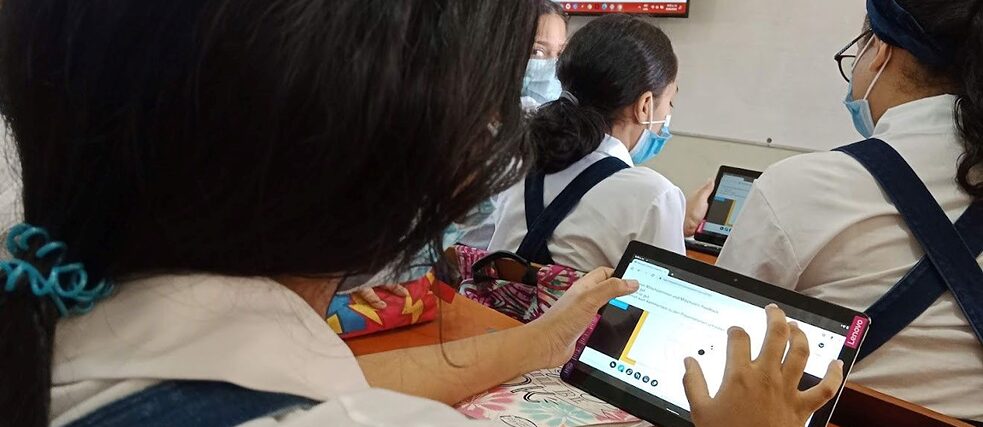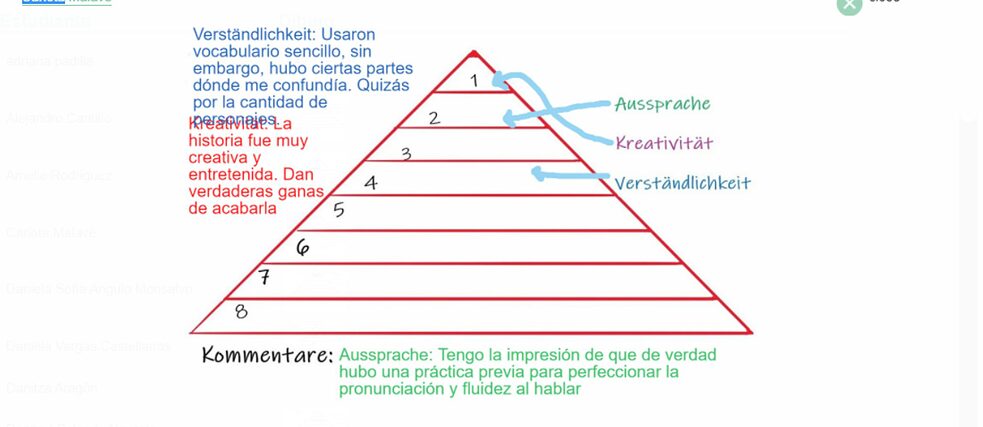Peer feedback in online teaching
Feedback is motivating: Online teaching methods

Positive feedback is motivating | © Adobe Stock
Motivation and participation are key factors in learning. So online instruction requires some special methods to achieve learning success and progress. And feedback is one such essential method. We tested various methods of peer-to-peer feedback in an interventional study in Colombia.
By Katharina Wedler and Ricardo Escorcia
Functions of feedback in teaching
Despite their importance, feedback processes are given short shrift in teaching. Unlike assessment in the form of grading, feedback should serve to make the learning process visible rather than focusing on results. If learners receive continuous individual feedback, it has a direct effect on their learning development: by showing them concrete ways to achieve a learning goal, feedback helps them to gain knowledge and skills.Feedback is the transmission of concrete information from a sender to a receiver. But feedback is not a one-way street. It also encompasses what the receiver has heard, seen and/or understood. The information exchange therefore runs both ways so as to ensure mutual understanding. In order to promote learning, feedback should address and continuously reduce the gap between the learning objective and the current level of proficiency in order to make the most of learners’ potential.
To this end, it’s essential for teachers to put themselves in learners’ shoes and understand that providing helpful feedback is a demanding task. It requires some subject-specific didactic, pedagogical and psychological skills.
Forms of feedback
To assess the effectiveness of feedback, Hattie (cf. 2013: 53) compared different forms of feedback and measured their “effect size” (d).
|
The table shows that in-process evaluation with feedback is significantly more effective than other feedback methods. Feedback in this case is a regular part of the learning process and progress towards learning goals. In the run-up to the achievement test, the teacher gauges learners’ progress on an ongoing basis, rather than basing that assessment on the results of the test alone. In the case of an achievement test without – as opposed to with – feedback, there is no subsequent conversation after the grading.
One of the most effective didactic approaches is to combine feedback only, formative assessment with feedback and self-assessment. This combination requires close observation – by both the teacher and individual learners. Studies have shown that self-assessment and peer feedback can also have a positive impact on self-regulated writing processes.
Peer feedback as a basis for discussion: An intervention study
In our six-week interventional study of 68 pupils aged 12 to 16 at the Instituto Experimental del Atlántico, a PASCH/Fit school in Barranquilla, Colombia, we tested the use of various feedback methods in online learning.The project was broken down into three stages. In the first two stages, pupils practised receptive and productive skills using a digital “boardstory” on the interactive reading portal Onilo. The third stage of the project involved members of the class giving feedback on the video presentations they’d put together in groups. The pupils evaluated their group’s videos using prescribed feedback methods.
Feedback methods in peer interaction
The “feedback pyramid” is a tool that sets the following assessment criteria: pronunciation, creativity and comprehensibility. The pupils rated each aspect on a numerical scale. They could also give feedback in the form of written comments. The pupils used Nearpod, a browser-based app for creating interactive presentations.
The so-called “target method” is similar to the feedback pyramid. The pupils focused on the three specified aspects of each video presentation and rated them on a scale of 1 (excellent) to 4 (not so good). Afterwards, the pupils were asked about the feedback methods. The majority (54%) of the respondents felt their comments help their classmates to improve. When asked about the challenge of providing feedback, 37% per cent said they found it somewhat difficult, while 32 per cent said they didn’t find it particularly difficult.
On the other hand, pupils find it easier to give feedback if the assessment criteria are established beforehand. 51 per cent of the pupils agreed that it’s important to give not only a score, but also comments explaining that assessment, which in turn corroborates Hattie’s findings on the importance of “feedback only”.
The results of the study show that pupils find it helpful to give and receive feedback from their classmates. Specific classroom activities can be used to practise this challenging task:
- Learning activities involving peer feedback in the form of brief comments
- “Traffic light” feedback using the Likert scale, from 1 (excellent) to 4 (room for improvement)
More classroom activity, more motivation
 Back in the classroom: feedback methods are used in in-person teaching, too.
| © Ricardo Escorcia
Classroom activity increased during the study, both written (through feedback in writing) and oral (discussing the terms of the assignment). The pupils had to negotiate the various steps with one another and share ideas on how to go about creating the story. They discussed their own skills and evaluated the feedback process as a positive effect. A number of apps and programmes, e.g. PowerPoint, Pear Deck, Nearpod, Mentimeter etc., proved particularly helpful in implementing feedback methods.
Back in the classroom: feedback methods are used in in-person teaching, too.
| © Ricardo Escorcia
Classroom activity increased during the study, both written (through feedback in writing) and oral (discussing the terms of the assignment). The pupils had to negotiate the various steps with one another and share ideas on how to go about creating the story. They discussed their own skills and evaluated the feedback process as a positive effect. A number of apps and programmes, e.g. PowerPoint, Pear Deck, Nearpod, Mentimeter etc., proved particularly helpful in implementing feedback methods.Using feedback methods with learners is essential for creating a democratic learning environment and learning culture in the classroom. It gives learners the feeling that their perceptions of their own learning processes and those of their classmates are taken into account and that they are involved in the execution and evaluation of their own course. This strengthens the pupils’ position. They take on more responsibility for their own individual learning process and, as a result, more agency and input in their own classes, which in turn boosts motivation. Working in so-called “breakout sessions” (online groups without a teacher) has proved quite effective in online classes. Breakout sessions require pupils to work consistently and autonomously. The quality of the results, products created one small step at a time, goes to show that this approach works.
References
Bastian, Johannes (2015): “Lernprozessorientiertes Feedback”. In: Pädagogik 7+8, 74-80.
Harks, Birgit; Rakoczy, Kathrin; Hattie, John; Besser, Michael; Klieme, Eckhard (2014): “The effects of feedback on achievement, interest and self-evaluation: The role of feedback’s perceived usefulness”. In: Educational Psychology 34 (3), 269-290.
Hattie, John (2009): Visible Learning: A synthesis of 800+ meta-analyses relating to achievement. London, New York. Routledge.
Hattie, John (2012): Visible Learning for Teachers: Maximizing Impact on Learning. London, New York. Routledge.
Lotz, Miriam; Lipowsky, Frank (2015): “Die Hattie-Studie und ihre Bedeutung für den Unterricht: Ein Blick auf ausgewählte Aspekte der Lehrer-Schüler-Interaktion”, In: Begabungen entwickeln & Kreativität fördern. Mehlhorn, Gerlinde; Schöppe, Karola; Schulz, Frank (eds), Munich: kopaed, 2015. 97-136.
Bastian, Johannes (2015): “Lernprozessorientiertes Feedback”. In: Pädagogik 7+8, 74-80.
Harks, Birgit; Rakoczy, Kathrin; Hattie, John; Besser, Michael; Klieme, Eckhard (2014): “The effects of feedback on achievement, interest and self-evaluation: The role of feedback’s perceived usefulness”. In: Educational Psychology 34 (3), 269-290.
Hattie, John (2009): Visible Learning: A synthesis of 800+ meta-analyses relating to achievement. London, New York. Routledge.
Hattie, John (2012): Visible Learning for Teachers: Maximizing Impact on Learning. London, New York. Routledge.
Lotz, Miriam; Lipowsky, Frank (2015): “Die Hattie-Studie und ihre Bedeutung für den Unterricht: Ein Blick auf ausgewählte Aspekte der Lehrer-Schüler-Interaktion”, In: Begabungen entwickeln & Kreativität fördern. Mehlhorn, Gerlinde; Schöppe, Karola; Schulz, Frank (eds), Munich: kopaed, 2015. 97-136.

